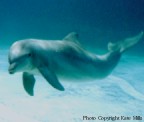
![]()
|
Dolphins are small,
toothed whales. They belong to the group known as cetaceans
(from the Latin word cetus, meaning large sea animal) which
includes all whales, dolphins, and porpoises. How many species are there? There are many different kinds of dolphins, around thirty or forty species of dolphins, including some species we would commonly call whales, such as orcas and pilot whales. Bottlenose dolphins (Tursiops truncatus) are one of the most wide-ranging species. They live along tropical and temperate coasts all around the world. Other species of dolphins live in cold waters, such as the Atlantic white-sided dolphin that can be seen from the Gulf of St.Lawrence to the North Sea, and the hourglass dolphin that lives in the waters of the Antarctic. How are dolphins like us? Dolphins and humans have a lot of things in common. First of all we are both mammals. We nurse our young, which are born alive, not hatched from eggs. Mammals breathe air. A dolphin must come up to the surface to breathe through a blowhole on the top of its head. When it dives, the blowhole closes shut. Rather than breathing continuously, like we do, a dolphin takes a breathe and holds it until it surfaces again. Unlike us, dolphins breathing is not automatic, so they have to think to breathe rather than think to hold their breath. Both humans and dolphins are warm-blooded. A dolphin's body temperature is normally 96-98.6 degrees Fahrenheit. Its outer body temperature is slightly lower. A human's body temperature is 98.6 degrees Fahrenheit just a fraction higher than a dolphin's. How do dolphins communicate? Dolphins communicate by making two types of sounds: vocalizations and echolocation. Vocalizations are the many noises dolphins use to communicate. These sounds come from there blowhole. Echolocation, also called sonar, is the way dolphins locate and distinguish between objects underwater. A dolphin emitts a sound and listens for the echo. This allows a dolphin to navigate through dark or murky water without bumping into anything. A dolphin produces powerful clicking sounds that travel through the water, which then bounce off objects and return to the dolphin. A whopping 1,200 clicks a second can be transmitted ahead of a dolphin like a beacon. These clicks come from the rounded forehead of the dolphin, called the melon. This melon along with the lower jaw are filled with a jelly-like substance used to smplifie sound waves. Therefore, as a dolphin swims, it moves its head back and forth to scan its surroundings, while the echos it sends out bounce off objects and hit the lower jawbone, which conducts the returning sound waves to the inner ear. By the pitch of the returning echo and the time it takes to get there, the dolphin can determine the shape, size, speed, texture, and density of the object. It can even view the inside of an object, almost like an X-ray, except it a dolphin has vision by sound. How many kinds of dolphins are there? There are over 33 different species of dolphins, over 5 different species of river dolphins, and over 6 different species of porpoise. Ocean Dolphins: Atlantic White-sided Dolphin, Atlantic Borneo White Dolphin, Bottlenose Dolphin, Borneo White Dolphin, Bouto Dolphin, Broad-beaked Dolphin, Cameroon Dolphin, Chinese White Dolphin, Clymene Dolphin, Commerson's Dolphin, Common Dolphin, Dusky Dolphin, Falkland Island Dolphin, Fraser's Dolphin, Heaviside's Dolphin, Hector's Dolphin, Hour-glass Dolphin, Long-snouted Spinner Dolphin, Northern Right Whale Dolphin, Pantropical Spotted Dolphin, Peale's Dolphin, Plumbeous Dolphin, Rio de Janeiro Dolphin, Risso's Dolphin, Rough Toothed Dolphin, Southern Right Whale Dolphin, Speckled Dolphin, Spinner Dolphin, Spotted Dolphin, Striped Dolphin, White- beaked Dolphin,White-bellied Dolphin, White-sided Dolphin. River Dolphins: Amazon River Dolphin, Baiji Dolphin, Indus River Dolphin, Ganges River Dolphin and Guiana River Dolphin. Porpoises: Black Porpoise, Black Finless Porpoise, Cochito, Dall's Porpoise, Finless Porpoise, Harbor Porpoise, Spectacled Porpoise, True's Porpoise.
|